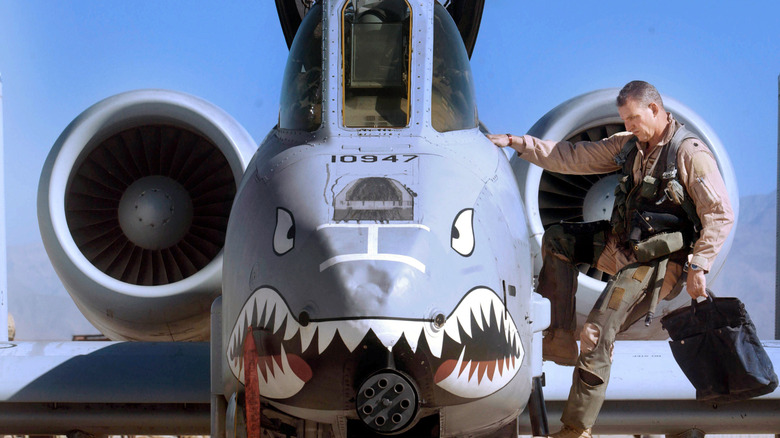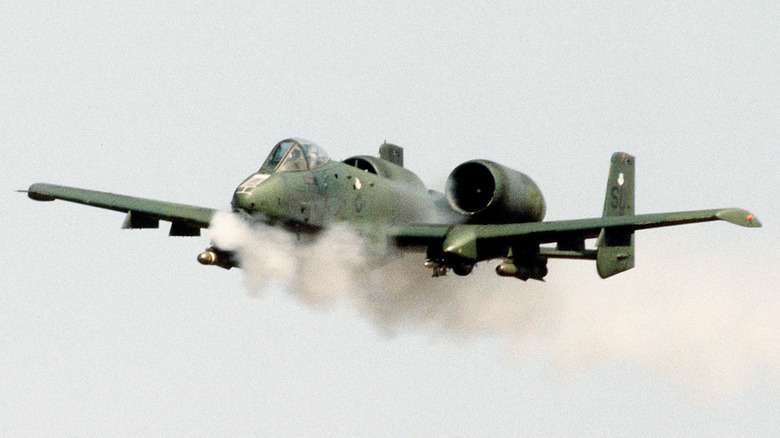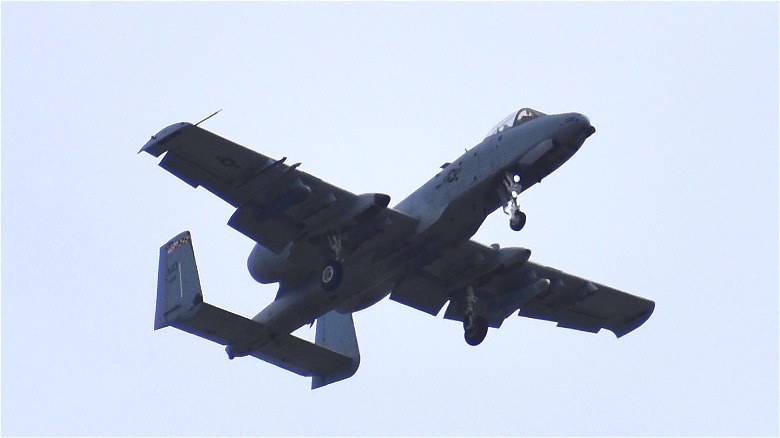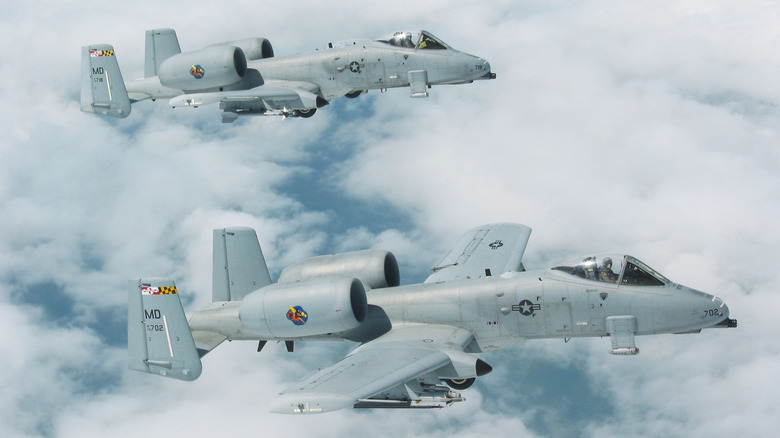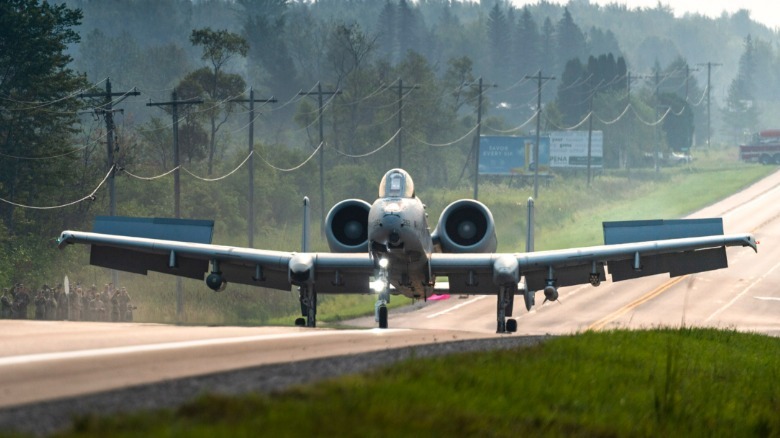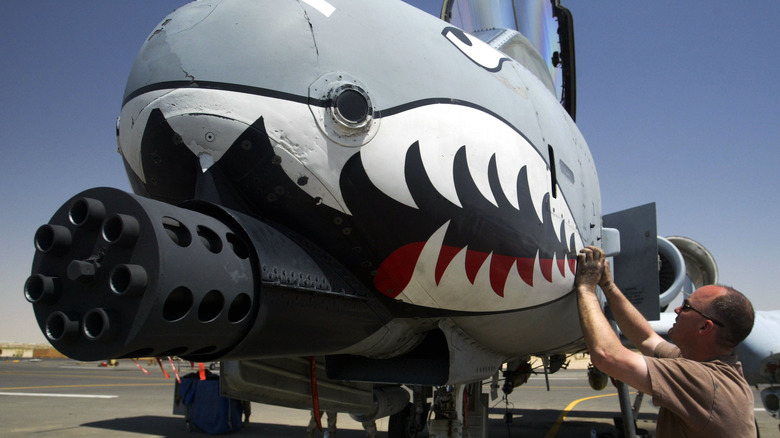The Incredible Capabilities Of The Legendary A-10 Warthog Attack Plane
High-tech stealth fighter jets like the F-22 Raptor have taken over the news cycle in recent weeks and are being used as the primary weapons to deal with potential threats in American and Canadian airspace. The Raptor and jets like it showcase the best the United States and its military has to offer when dealing with airborne targets both inside the borders of the States and abroad.
But the U.S. Air Force is comprised of more than just fancy fighter jets tailor-made to pop spy balloons and deal with enemies in the sky. The United States' airborne capabilities extend to dealing with threats on the ground too in the form of close ground support aircraft. In combat, a soldier might see a fighter jet fighting other aircraft overhead or drop a bomb or two on a target and get out before the enemy can respond.
Ground support aircraft hang around the battle space and provide direct support to soldiers as long as it is needed to knock out tanks, armored vehicles, buildings, or whatever else needs to be taken out of commission. The United States' premier ground attack aircraft is the Fairchild Republic A-10C Thunderbolt II, or just simply "The Warthog."
The Warthog is a big flying gun
The Warthog has been in the United States arsenal since 1976 and serves with both the Air Force and the Air National Guard of several states. Officially, it is a close air support fighter used to kill tanks. Unofficially, it's a flying gun. Fighter jets are made to fight other jets and ensure air superiority in a chosen battle. The A-10 is made to fight everything else.
Take one look at an A-10 and you'll immediately notice the huge gun protruding from the nose of the aircraft. That gun is a GAU-8/A "Avenger" 30mm Gatling gun; it can fire 3,900 rounds a minute with a muzzle velocity of 3,400 feet per second, according to General Dynamics. This will render just about every vehicle on Earth completely ineffective after just a short burst of rounds.
The gun was developed in the 1970s alongside the aircraft itself to defeat Soviet armor but was used to great effect in Operation Desert Storm. The gun itself actually consists of seven barrel assemblies that each fire every time the weapon spins. If one barrel worked full-time to fire nearly 70 rounds a second, it would melt. Instead, the work is divided across seven barrels to allow each barrel time to cool down.
The plane can take a beating
In addition to the giant gun, the A-10 can hold up to 16,000 pounds of ordnance in the form of GPS-guided bombs, air-to-ground missiles, AIM-9 Sidewinder missiles (just in case any Chinese spy balloons show up again), and whatever else can fit under its wings.
The plane's bizarre-looking airframe is a perfect example of function over form. Not only can it take a hit and keep fighting, it is capable of making what the Air Force calls "austere" landings, meaning it can land anywhere that's long enough and flat enough to hold the plane. In fact, on August 5, 2021, an A-10 from the Michigan Air National Guard landed on a highway as part of a training mission.
Notably, Captain (now Major) Kim Campbell of the 75th Expeditionary Fighter Squadron demonstrated the A-10's remarkable ability to take a punch after it was hit by an anti-aircraft missile on April 7, 2003, while on a support mission in Iraq. Though the missile knocked out the aircraft's hydraulic control systems, Captain Campbell was able to manually fly the aircraft back to safety relatively easily thanks to the Warthog's built-in manual control override system. She was awarded a Distinguished Flying Cross.
The A-10's future
The A-10 will comfortably fly at 420 miles per hour. That's much faster than a Bugatti and would be impressive for the 1940s, but that is just a fraction of the speed that fighter jets like the aforementioned F-22 Raptor regularly fly at. Each engine only outputs 9,065 pounds of thrust; compare that to the F-22 Raptor's combined thrust of around 70,000 pounds.
The A-10, however, is not supposed to be fast — it's practically a tractor compared to the F1 car-like F-22. It's meant to fly low and slow and hang around as long as possible and keep its guns, rockets, and bombs on target to both help out friendly troops on the ground and give the enemy something to think about.
The aircraft will enter its 50th year of service in 2026 and companies like Boeing are hard at work keeping the planes in the air making wing upgrades. As planes like the F-35 Joint Strike Fighter join the arsenal, the A-10 will get shifted around to different roles in the future, but the U.S. plans to keep the Hog flying until well into the 2040s. At a unit cost well below the cost of a newer aircraft, the A-10 is as cheap as it is deadly.
